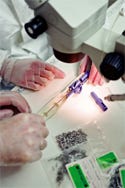Product Developer Obtains ISOCertification, State Food and DrugBranch Approval
Wireless data collected directly from patients during normal physical activities could enable the development of better knee implants
April 13, 2008
Originally Published MPMN April 2008
NEED TO KNOW
Product Developer Obtains ISOCertification, State Food and DrugBranch Approval
|
Hiemstra's cleanroom supports the manufactureand assembly of such products as surgical tools and catheter-based drug-delivery systems. |
On the heels of receiving ISO 13485 certification for its contract design quality system, Hiemstra Product Development LLC (San Francisco; www.hiemstra.com) has been granted state approval to manufacture Class I–III devices in its cleanroom. A firm can receive approval from the Food and Drug Branch (FDB) of the California Department of Health Services Division of Food, Drug, and Radiation Safety following an audit of a facility and its design and GMP systems. Because of the FDB approval, Hiemstra can now assist customers from the development stages of a product through first-in-man studies, ongoing clinical trials, and low- to medium-volume production during early ramp-up.
Early involvement in the process can be critical, given the complexity of product development and regulatory approval, says Hiemstra marketing consultant Nina Binetti. “We are seeing an increased interest to integrate our industrial design group up front in the product development process for better usability and value-added design elements,” she says. “We definitely see industrial design becoming [a bigger] part of the process. With our FDB approval, ISO certification, and quality management system, all of our processes are now interconnected to provide the highest-quality outputs in the most efficient manner.”
The company’s 750-sq ft, Class 10,000 cleanroom is equipped to handle manufacturing runs of a few hundred up to 30,000 units. The cleanroom will enable the company to expand its existing capabilities, working with such products as implants, surgical tools, power supplies and enclosures, and drug-delivery systems. In addition to offering manufacturing support for these types of products, the company also is expanding its design and development programs to service the growing market of combination products. “New combination products are providing effective treatment options where traditional options have previously failed. We see a growing pipeline of novel combination products in the areas of nano- and biotechnology, regenerative medicine, and orthopedics, in particular,” says Binetti.
With the number and variety of medical products continuing to increase, Binetti suggests there is a need for greater understanding of the regulatory approval process. “Regulatory requirements are continuously changing,” Binetti says. “Pathways that were successful for a device in the past may not hold today. Hiemstra can help customers find the most efficient regulatory process.”
Copyright ©2008 Medical Product Manufacturing News
You May Also Like



